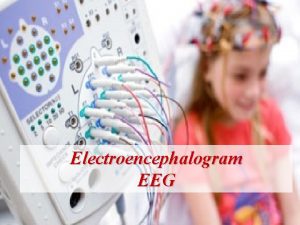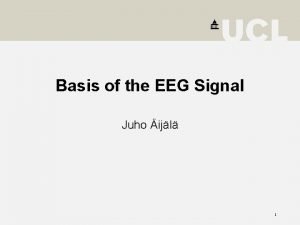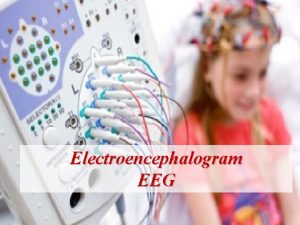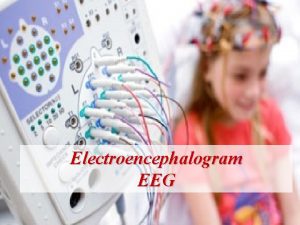Measuring sleep EEG electroencephalogram used to measure the




- Slides: 4

Measuring sleep EEG (electroencephalogram) • used to measure the gross brain activity (the summary of electrical activity from one area of the brain, i. e. the pattern of brain waves) • Useful to determine the type of brain wave associated with each stage, e. g. beta waves, delta waves. EMG (electromyogram) • Used to measure the electrical activity of a muscle • Useful in the REM stage when measuring muscle tone to notice any temporary paralysis EOG (electrooculogram) • Used to measure eye movement • useful in the REM stage when measuring the darting eye movements

Stages of Sleep 1 and 2 • This is as you go to sleep and you are in a very light sleep • If a sleeper is woken up whilst in these stages, they will often say that they were not actually asleep. 3 and 4 • This is characterised by a deeper sleep • It is difficult to wake someone up from deep sleep, and if you do manage to wake them up then they will be confused and disorientated • However, certain noises will still wake you up, for example if a mother hears her baby crying then this will wake her up • This stage is where sleepwalking and sleep talking are mostly likely to occur REM (rapid eye movement) sleep • During this stage, darting eye movements will occur • this stage is associated with dreaming • It is characterised by a lack of muscle tone, which results in temporary paralysis

When you are awake, your brain waves take the pattern of beta waves. These have small wave frequencies and amplitude. when you are in stages 1 and 2 of sleep, your brain waves take the pattern of theta waves. These have an even greater wave frequency and amplitude. When you are relaxed, your brain waves take the pattern of alpha waves. These have a greater amplitude and wave frequency. When you are in stages 3 and 4 of sleep, your brain waves take the pattern of delta waves. These have the greatest wave frequency and amplitude. In the REM stage of sleep, the pattern of your brain waves are unique – they are fast and desynchronised. They resemble the awake state i. e. the EEG activity is similar to the activity of a beta wave.

Sleep cycle • For a normal night of sleep, a person will progress through the 4 sleep stages, ending up in deep sleep. • This is followed by a return back through stages from 4 to 3 to 2, and instead of back to 1, it goes to REM sleep. • This cycle is repeated throughout the night, and lasts roughly 90 minutes • So if you sleep for 7 ½ hours, then you should go through 5 full sleep cycles • During the course of the night, the length of the REM episodes increases and the length of stages 3 and 4 decreases in each cycle, until there is no delta activity at all.






